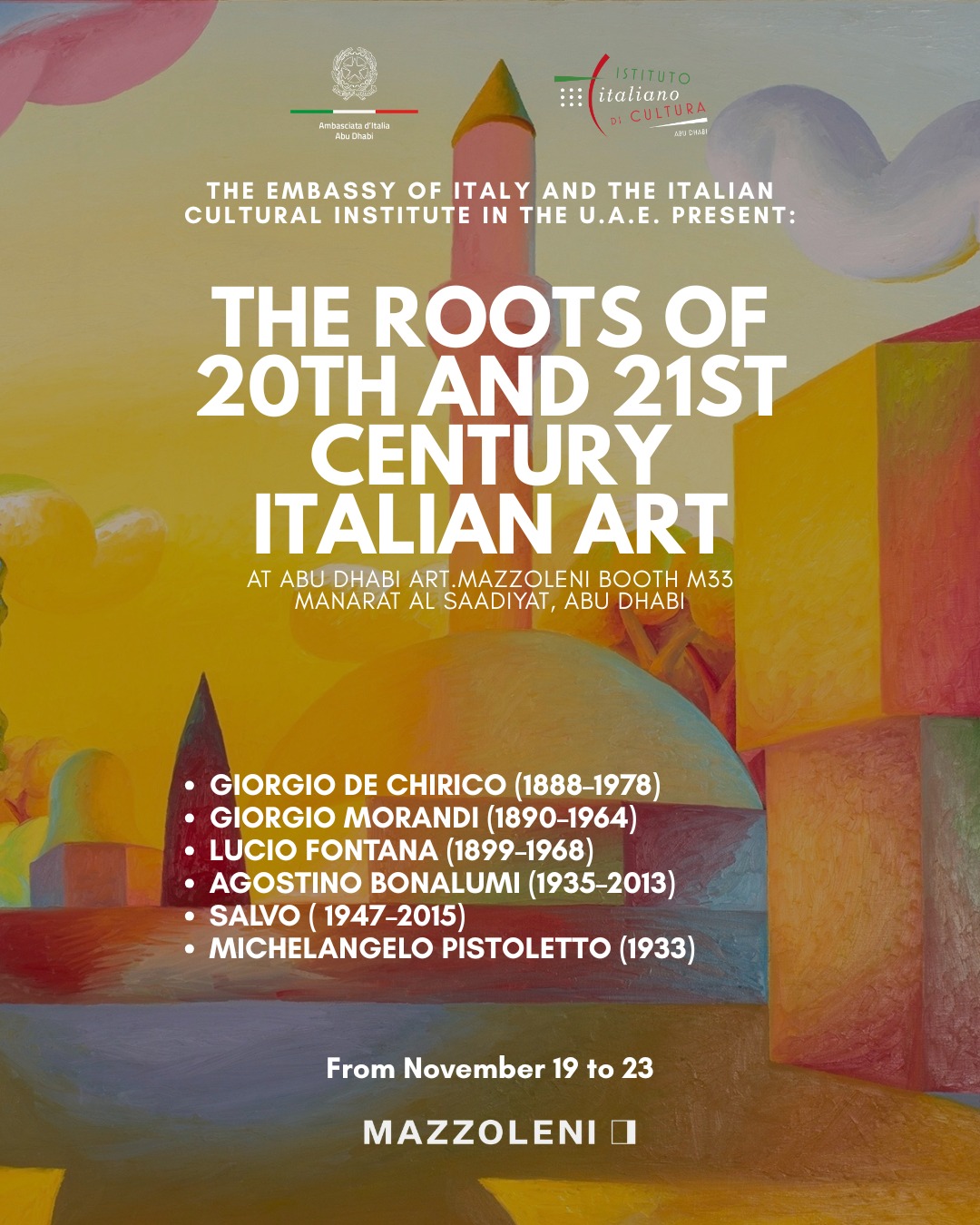“The Roots of the 20th and 21st Century Italian Art”
The 17th edition of Abu Dhabi Art, the flagship cultural event of the capital of the United Arab Emirates, will take place from 19 to 23 November 2025 at Manarat Al Saadiyat. The Fair will bring together over 140 galleries from 37 countries.
The Italian Cultural Institute in Abu Dhabi and the Embassy of Italy in Abu Dhabi, in collaboration with Galleria Mazzoleni, are pleased to present the exhibition project “The Roots of the 20th and 21st Century Italian Art.”The presentation event and guided tour of the exhibition will take place on 19 November at 6:00 PM at booth M33. To participate, please send an email to abudhabiiic.segre@esteri.it. Limited spots available.
Italian art, including that of the 20th century, has consistently distinguished itself through an extraordinary ability to renew artistic languages with solutions that remain strikingly modern to this day. In a dialogue between past and present, memory and experimentation, the works of seven renowned Italian masters are brought together in “The Roots of the 20th and 21st Century Italian Art”: Agostino Bonalumi, Enrico Castellani, Giorgio de Chirico, Lucio Fontana, Giorgio Morandi, Michelangelo Pistoletto, and Salvo. Several of these artists have rarely, if ever, been exhibited in the United Arab Emirates.
The title of the exhibition reflects the commitment of the organizing institutions to promote internationally the creative achievements of some of Italy’s most brilliant artists of the last century – Pistoletto being still fully active today – whose works have influenced a wide range of contemporary artists. Each of the seven artists explored reality in a profound and personal way, addressing themes such as time, space, being, and the fundamental elements of an artwork such as surface, volume, and color.
Following a chronological progression through the history of modern and contemporary art, the exhibition highlights:
Giorgio de Chirico (1888–1978), who in the early decades of the 20th century founded Metaphysical Painting, laying the foundations for Surrealism and significantly influencing international art of the 20th and 21st centuries. Classical architectures, his horses among ruins as seen in Cavalli in riva al mare, his mannequins – The pittore paesista being an example – and the long shadows evoke a suspended world: a “meta-reality” in which time seems to have paused to reflect upon itself. Within his work coexist philosophical thought, myth, and a nostalgia for the lost grandeur of antiquity. De Chirico presents an art that does not merely depict reality, but transcends it, suggesting an enigmatic and mysterious dimension.
Giorgio Morandi (1890–1964), seemingly detached from avant-garde movements, developed a deeply personal and highly recognizable language rooted in silence and contemplation. His still lifes – bottles, vases, and boxes carefully arranged – transcend their appearance as mere objects to become mental landscapes, spaces for visual meditation.
Lucio Fontana (1899–1968), a radical innovator and founder of Spatialism, whose celebrated Concetti Spaziali broke through the limits of the pictorial surface. Iconic gestures such as cuts and punctures transformed the canvas into an open space, as exemplified in Concetto spaziale, Attesa (1966).
In the 1960s, the dialogue on space, form, and color was expanded by artists closely connected to Fontana. Enrico Castellani (1930–2017) and Agostino Bonalumi (1935–2013) created extroflexed or indented surfaces by placing structures behind the canvas, generating rhythmic visual effects through light and shadow. By eliminating figuration, both artists treated the surface as an active, dynamic space.
Salvo (1947–2015), after an early conceptual phase in the late 1970s, returned to figurative painting around 1973. He depicted landscapes, architecture, and scenes rich in references to art history, drawing inspiration from the Italian Renaissance, Dutch 17th-century painting, French classicism, Futurism, and de Chirico.
The exhibition concludes with Michelangelo Pistoletto (1933–), a leading figure of Arte Povera. His first mirror painting, produced in 1962 by transferring a photographic image onto tissue paper and applying it to polished stainless steel, marked the beginning of a lifelong exploration of reflection and society. Through the mirror, life itself enters the work of art, constantly evolving. A notable example is Smartphone – Standing Woman and Seated Woman (2018).
On the occasion of the exhibition, Ambassador Lorenzo Fanara remarked:
“The organization of this exhibition of Italian masterpieces by the Embassy of Italy and the Italian Cultural Institute, in collaboration with Mazzoleni Gallery, confirms our strong commitment to cultural diplomacy as a tool for building bridges of dialogue and understanding. It is particularly significant that the exhibition takes place within the extraordinary context of Abu Dhabi Art, an international crossroads for artists, galleries, and collectors from around the world. In this way, the most current expressions of Italian art will be presented not only to Emirati audiences, but also to the thousands of international visitors attending Abu Dhabi Art.”
The Director of the Italian Cultural Institute in Abu Dhabi, Susanna Iacona-Salafia, added:
“This exhibition is a tribute to the richness and complexity of Italian art. In an international setting such as Abu Dhabi, it aims to create a cultural bridge between Italy and the United Arab Emirates, between the Mediterranean and the Gulf, between tradition and contemporary creativity. The works on display are not merely testimonies of the recent past, but living instruments to better understand the present and to imagine the future of Contemporary Art.”






